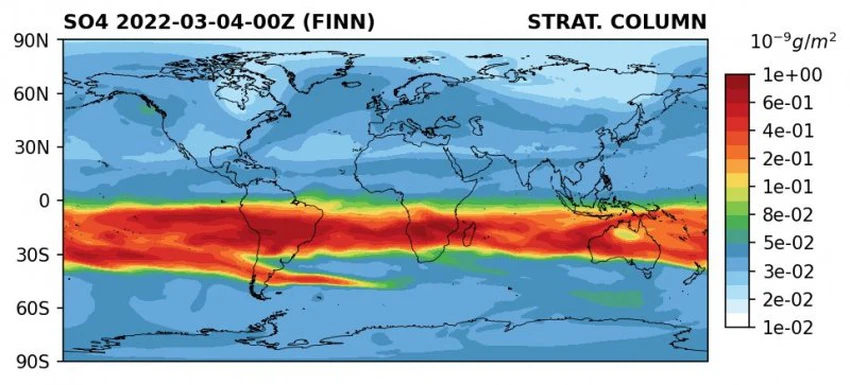Monitoring large amounts of emissions from the Tonga volcano in the stratosphere.. Are there possible effects on the climate?
Weather of Arabia - Most of the global climate centers are watching whether the Tonga volcano has potential consequences for the planet's climate during the next few years, in light of monitoring large quantities of sulfur dioxide particles and volcanic ash that resulted from the explosion of the Tonga volcano moving in the stratosphere.
There are currently about 500 active volcanoes in the world, all of which do not affect the climate. As long as the volcanic eruption does not exceed high altitudes, the ash is subject to vertical winds and sediments and deposits quickly, but when it is thrown to the next layer in the atmosphere (the stratosphere), it remains for a long time, This is because the stratosphere is a completely stable layer without large vertical currents in which light ash particles can float for several months and their deposition is very slow.
Was the eruption of the Tonga volcano strong enough to affect weather patterns?
Tonga volcano, which erupted earlier in mid-January 2022, released a huge column of smoke and ash that exceeded approximately 30 km above the surface of the earth, to be the most powerful in three decades, specifically since the Pinatubo volcano in the Philippines, which had a great impact on making a tangible change in the world. Atmospheric patterns prevailing at the time on planet Earth.
According to the numerical models that specialize in sensing the chemistry of the atmosphere, it was estimated that what was released after the eruption of the Tonga volcano was about 400,000 tons of sulfur dioxide particles, and despite its stay at high altitudes from the Earth’s surface in the atmosphere, its impact reaches heights close to The surface of the Earth, especially in those layers that control the weather and the shape of weather patterns, after the volcano ejects it, sulfur dioxide turns into sulfuric acid mist, which reduces sunlight from reaching the ground, and thus limits the amount of warmth we receive from the sun.

The specialists of the Arab Weather Center believe that when comparing the amount of emissions and aerosols injected into the stratosphere as a result of the eruption of the Tonga volcano with those volcanoes that have caused remarkable climate change during the past decades, it becomes clear that the amount of emissions generated by the Tonga volcano is very few and limited if compared, for example. With the Pinatubo volcano, which then released up to 20 million tons of sulfur dioxide, which is 50 times that of the Tonga volcano.
In a larger and more comprehensive event, the Tambora volcano, which erupted in Indonesia in 1816, released more than 58 million tons of sulfur dioxide particles that penetrated the highest layers of the atmosphere, and the result was that the year 1816 was known as the year without summer. Three years after the temperature of the planet decreased and weather disturbances prevailed, storms, snows, droughts, diseases (cholera), the revolutions of the hungry in Europe (famines), the failure of agricultural crops and economic depression, and millions died as a result, and the value if compared also with that amount produced by the Tonga volcano represents about 150 weakness.
Expected limited effects of emissions from the Tonga volcano
Specialists at the Arab Weather Center say that sulfuric acid spray will continue in the atmosphere for up to two years and dissipate within five years, and they do not see that the effects will be tangible on weather patterns, including global temperatures, and this is supported by the speculation of scientists and they are many that the average The Earth's surface temperature will decrease by only 0.004°C during the first year after the eruption of Tonga, meaning that the eruption of the Tonga volcano is not strong enough to have significant and tangible effects on the global climate. And specialists in the center add that the effects may be felt in areas close to the occurrence of the volcano, including parts of Australia.
Arabia Weather App
Download the app to receive weather notifications and more..



